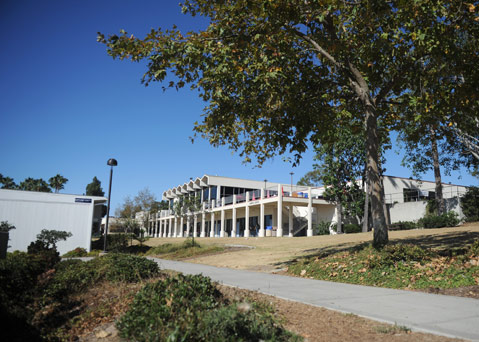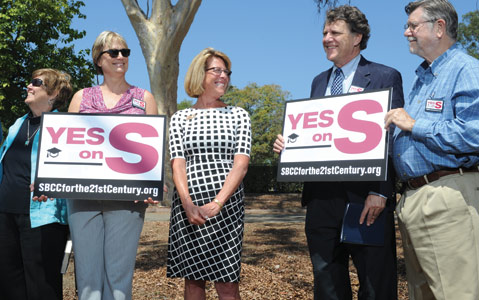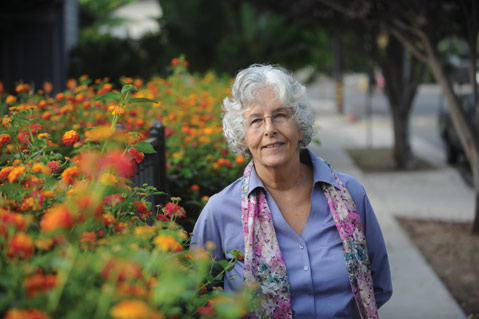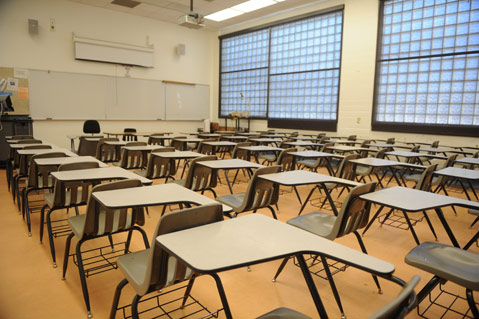City College’s Sprawling Impact
Democrats Flip-Flop for Measure S

A number of apartment buildings across the street from Santa Barbara City College (SBCC) have become unsanctioned residence halls for students, but there is no supervision. Music blares late from roosting out-of-area students who recently flew their parents’ coop. These young people often double and triple up in bedrooms. “There’s a bunk bed in a room made out of half of a kitchen,” quipped lower Westside resident Beebe Longstreet. Six cars line up in the driveway located next door to her house; many are quite fancy and driven by 18-year-olds.

At times, disturbances surpass juvenile delinquency and are downright violent, neighbors claim. And since Santa Barbara City College enacted a smoking ban in the summer of 2013, cigarette butts litter streets surrounding campus. The area has turned into something of a mini Isla Vista in the past five years or so, neighbors say, as low-income families and young professionals moved out and students moved in. The school promotes 10 complexes on its website, though they are not affiliated with the college.
Unlike the unincorporated land of Isla Vista, which is governed by county law, the city does not have a noise ordinance to specifically address college partying. Police officers can issue tickets pursuant to the Penal Code sections that define disturbing the peace, which includes construction noises or loud music. But officers rarely issue tickets in the neighborhoods near the college, because it requires a complainant to perform a citizen’s arrest. So the young adults, not surprisingly, tend not to fear the cops.
Santa Barbara City College has jumped into the spotlight lately because it is asking voters to approve a $288 million facilities bond known as Measure S. Longstreet recently took to the Board of Trustees to voice neighbors’ complaints, and a neighborhood task force was created to tackle some of these problems. (The meetings are unrelated to Measure S and will continue after the election regardless of the outcome.) Chaired by Trustee Marty Blum, the task force is made up of 15 police officers, City Hall representatives, students, neighbors, and deans. “We’re cautiously optimistic that changes can be made,” said neighbor Mark Taylor, who has been involved in this issue for some time. A group similar to the new task force was formed about a year ago, but no apparent progress was made.
The sticking point this time may be that the college hired Daniel Iacofano — who worked on similar college-city issues in San Francisco — to facilitate the task force. So far, ideas to mitigate the rambunctious behavior include implementing new noise and nuisance ordinances, requiring additional orientations for students, and redesignating a smoking area on campus. They plan to meet five or so more times by January when they will produce a report to present to the trustees.

Neutral to Supportive
On the same night the neighborhood task force met, the Democratic Party of Santa Barbara County voted to endorse Measure S, rescinding its September decision to take a neutral stance. The Dems discussed facilities at great length during three previous meetings, touching on issues of oversight, construction projects, and student housing. SBCC President Lori Gaskin said she was “elated” by the party’s decision to endorse Measure S, though she specified her purpose is to inform rather than to advocate.
The facilities bond, if it passes, will be issued in four series and will be paid for over the next several decades. The money would pay for a new campus center, a new classroom building on east campus, the Wake Center, and the physical education buildings. Modernizations include buildings for occupational education, marine diving technology, student services, the Schott Campus, physical sciences, the administration building, and the library, according to school’s targeted projects. In response to concerns that the $288 million would be a “blank check” for the college, Gaskin said the amount was derived from a long-term study of the facility’s needs. “I can’t control what a [Board of Trustees] does 10 years from now,” she said. “My ethical compass is on protecting the infrastructure that we currently have.”
About $19 million still remains from Measure V — the $77 million facilities bond passed by 70 percent of voters in 2008 — and is allocated for a classroom building on the west campus, which will eliminate 32 of the campus’s 51 portables. (At the time, there was virtually no vocal opposition to Measure V.)
The Democratic Party’s endorsement effectively means new “Yes on S” mailers will come with the “Democratic Party” stamp. (Flyers printed before the latest vote read “Democrats Are Standing Up for Measure S!” and picture 10 prominent Democrats who personally endorsed the bond.) Now, “Yes on S” will be folded into the party’s campaigning, which has been ongoing since August.
Most of the members shifted their vote because Gaskin gave a “specific” and “concrete” statement about how Measure S funds would be used to tackle the housing crisis, according to chair Daraka Larimore-Hall. Gaskin pledged the college and its board are committed to spending money to deal with the whole package — housing, circulation, transportation, and parking. Last year, the SBCC Foundation placed a bid to purchase Harbor Heights located adjacent to the college, but it lost to a $33 million bid by St. George & Associates, which owns several dozen student rentals in Isla Vista.
The assurance from Gaskin represents a shift as community college officials have historically iterated that it is not in their mission to provide housing for students. That has changed to a degree; now 11 out of the 112 community colleges in the state system offer housing for students. But most are located in sparsely populated rural areas up north. And some need dorms to attract students.
Constructing new housing on campus would not be feasible, Gaskin said, but she would like to model private partnerships after Tropicana Gardens, which houses SBCC students in a dorm-style complex in Isla Vista.
If Measure S fails, the college would likely have to go back to the voters in two years with a smaller requested amount. Without the bond money, the college would be unable to build classrooms or housing, argued Assemblymember Das Williams, who spoke to the Dems with Gaskin. Williams added that all community colleges with “superior academic programs” — some are in attractive places to live — also see an influx of students. “It’s a state institution,” he said, adding that Santa Barbara students who go on to CSU or UC campuses benefit from the entire system.

Few, but Vocal
Opposing the measure, “No on S” comprises a group of about nine volunteers, some of whom have worked anonymously for several weeks. Outspoken crusader Ernie Salomon, who was instrumental in starting the campaign, formally resigned from the group so he could respond to emails more quickly — without needing the group’s approval. Glen Mowrer, retired public defender and public access channel host of The Next Step, is now leading the group. “No on S” has raised $2,260 to date. “Yes on S” has accumulated $338,345 in its campaign piggy bank, including $250,500 from the SBCC Foundation, $10,000 from Compass Energy Solutions and Griffith & Thornburgh LLP, and $5,000 from Penfield & Smith and PMSM Architects.

Adult Ed Anxiety Continues
Fears about the future of the college’s two satellite campuses is prevalent among the Adult Education crowd, who worry that for-credit students will eventually displace students enrolled in the Center for Lifelong Learning (CLL). Though cosmetology will move out to the Wake campus, Gaskin said the program will not eliminate any current Lifelong Learning courses. A few years ago, Adult Education transitioned from a state-subsidized program to a fee-based, self-sufficient school, creating serious controversy and anguish among the Adult Ed population. Though the number of unduplicated students dropped from about 20,000 to 7,500, executive director Andy Harper said the center broke even after its first year and called worries that CLL would be eliminated an “unfounded fear.”



